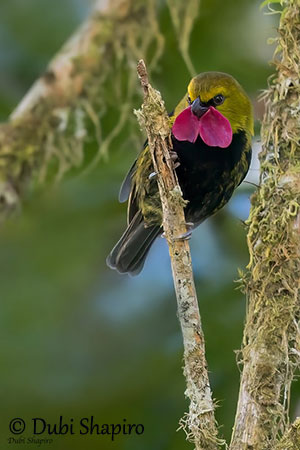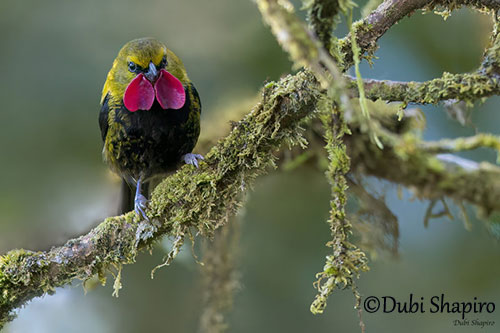
Fr: Écorceur caronculé
Ang: Wattled Ploughbill
All: Lappenpflugschnabel
Esp: Silbador Picoarado
Ita: Aratore crestato
Nd: Leldikkop
Sd: plognäbb
Photographer:
Dubi Shapiro
Dubi Shapiro Photo Galleries
Illustrator:
John Gerrard Keulemans (1842 – 1912)
Text by Nicole Bouglouan
Sources:
HANDBOOK OF THE BIRDS OF THE WORLD Vol 12 by Josep del Hoyo-Andrew Elliott-David Christie - Lynx Edicions - ISBN: 8496553423
Birds of New Guinea: Second Edition De Thane K. Pratt, Bruce M. Beehler – Editeur: Princeton University Press, 2014 – ISBN: 0691095639, 9780691095639 – 528 pages
Birds of New Guinea: Distribution, Taxonomy, and Systematics De Bruce M. Beehler, Thane K. Pratt – Editeur: Princeton University Press, 2016 – ISBN: 069116424X, 9780691164243 – 672 pages
Fatbirder - The World’s Richest Information Resource about Birds for Birders
CREAGUS@Monterey Bay (Don Roberson)
New Guinea Birds - Eulacestoma nigropectus
Wikipedia, the free encyclopaedia
Wattled Ploughbill
Eulacestoma nigropectus
Passeriformes Order – Eulacestomatidae Family
INTRODUCTION:
The Wattled Ploughbill is the only member of the genus Eulacestoma in the family Eulacestomatidae. It is a monotypic species. The name “Eulacestoma” comes from the much compressed and plough-shaped form of the bill.
It was formerly related to the whistlers of the family Pachycephalidae, but genetic studies have shown that the genetic and morphological uniqueness of this bird deserved to have its own family.
The Wattled Ploughbill is endemic to the central mountain ranges of New Guinea. It lives in forest and adjacent areas with dense regrowth. It feeds primarily on insects caught from the forest floor to the mid-level of the forest.
The breeding behaviour is poorly known, but both mates are suspected to share most of the nesting duties.
The Wattled Ploughbill is described as rare to uncommon or fairly common in most of its restricted range, and currently, the species is not globally threatened.

DESCRIPTION OF THE BIRD:
Biometrics:
Length: 12,5-14 cm
Weight: 19-22 g
The Wattled Ploughbill adult male is a small, dumpy bird. The upperparts are ochraceous-olive with more golden on scapulars. The feathers of back, rump and uppertail-coverts show greenish-yellow edges, but almost yellow on mantle sides. The upperwing is fuscous-brown with olive-grey edges to primaries and rufous-olive edges to secondaries. The wing-coverts are black, but the greater have olive-green edges. The tail is brown with olive edges to rectrices.
On the underparts, chin and upper throat are pale yellow, whereas lower throat and breast are black. Belly, vent and undertail-coverts are yellowish. Both underwing and undertail are pale slate-brown. On the underwing, the axillaries are greenish-grey and the wing-coverts are grey.
On the head, the crown is ochraceous-olive. The lores are black. Forehead, face and ear-coverts are more golden.
The most striking feature of the male is the large, circular, pink wattles similar to two rose petals, extending from the gape to the sides of the throat.
The bill shape is peculiar too. The short, deep, sooty-black bill has a hooked upper mandible, and head-on, the bill appears to be laterally compressed. This special shape is well-adapted to the foraging behaviour of the species. Both nasal and rictal bristles are short and weak.
The eyes are dark reddish-brown.
Legs and feet are grey.
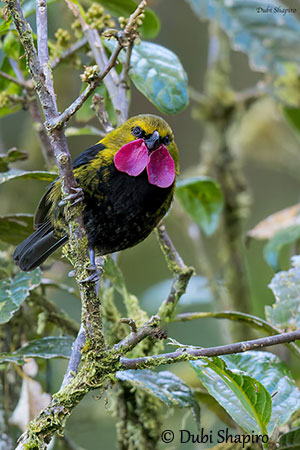
The female resembles male but she lacks the wattles.
The underparts are paler, mostly pale olive, with indistinct whitish barring on the breast.
The bill is greyer and the eyes are brown.
The juvenile has rusty-chestnut upperparts with rusty wing-coverts. Flight-feathers and rectrices have rusty-chestnut edges. The breast is grey tinged rusty.
The immature resembles adult female but the wing-coverts are still rusty like in juvenile plumage.
RANGE:
The Wattled Ploughbill is found in C and E New Guinea, from Weyland Mts, E to Owen Stanley Range in SE. It is endemic to this mountainous region.
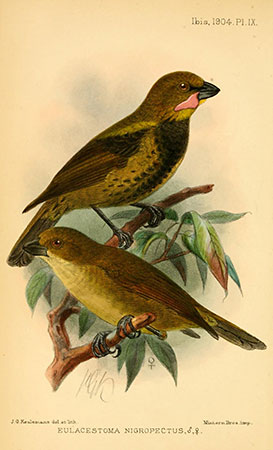
HABITAT:
The Wattled Ploughbill frequents the cloud forests in C New Guinea where it occurs in thickets of climbing bamboo in the wet montane forest, between 1,950 and 2,850 metres of elevation. It can be found locally down to 1,250 metres in SE.
CALLS AND SONGS: SOUNDS BY XENO-CANTO
The Wattled Ploughbill has several songs and calls. While perched at treetop or in mid-story, it gives a high, thin, long whistle, and also a series of about six rising and falling whistled notes. We can also hear a buzzy, repeated note.
BEHAVIOUR IN THE WILD:
The Wattled Ploughbill feeds mainly on insects. It forages alone or in pairs, but it may join mixed flocks of small insect-eaters.
It forages from the understorey to the middle-level of the forest up to 10 metres, especially in bamboo thickets. It vigorously digs and hammers on bark, dead wood and bamboo. The well-adapted hooked and laterally compressed bill helps the bird with its specialized foraging strategy of chipping or stripping away the bark to get the insects hidden beneath.
It also forages by hopping about or hanging upside-down to check the underside of limbs. It can be seen searching for insects in humid, mossy forest, and mainly in dense, regenerating vegetation.
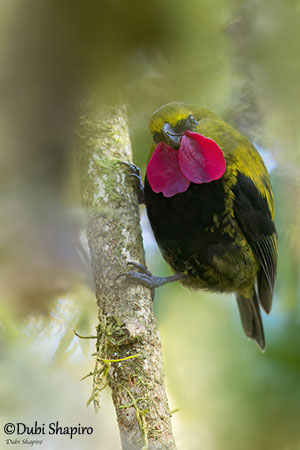
The breeding behaviour is poorly known.
The Wattled Ploughbill was formerly included in the family Pachycephalidae, and it probably retains some features related to this family. These birds are monogamous and breed as simple pairs. They build a cup-shaped nest.
The Wattled Ploughbill is also named Wattled Shrike-tit. The shrike-tit species build their nest in the upper canopy, up to 30 metres above the ground in a vertical fork. They also have the unusual habit of cleaning away the foliage above and just below the nest. They may sometimes have helpers.
The courtship displays of the Wattled Ploughbill are unknown, but we can suggest that the large, pink wattles are conspicuously displayed while the male adopts adapted postures.
More information is needed.
The Wattled Ploughbill is probably sedentary with only some altitudinal movements.
This species has broad, rounded wings, well-adapted to the foraging behaviour and the sedentary nature of the bird.
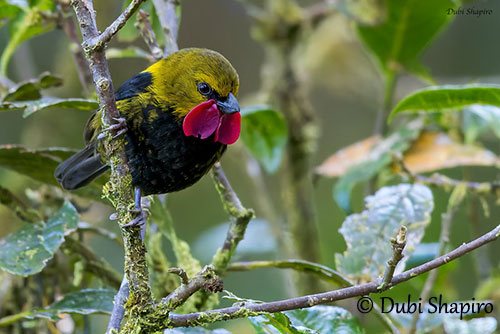
REPRODUCTION OF THIS SPECIES:
A female in breeding condition was observed in July, involving probably two breeding periods during both wet and dry seasons.
The nesting duties are presumably shared by both mates and incubation by male is reported.
Juveniles were observed in May and late June.
No more information.
PROTECTION / THREATS / STATUS:
The Wattled Ploughbill is described as rare to uncommon throughout the range, and locally fairly common in SE.
The species has restricted range. The population is suspected to be stable and not globally threatened.
The Wattled Ploughbill is currently evaluated as Least Concern.
